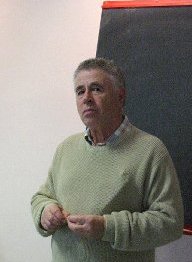
Wolfgang Ketterle (born 21 October 1957) is a German physicist and professor of physics at the Massachusetts Institute of Technology (MIT). His research has focused on experiments that trap and cool atoms to temperatures close to absolute zero,[1] and he led one of the first groups to realize Bose–Einstein condensation in these systems in 1995.[2] For this achievement, as well as early fundamental studies of condensates, he was awarded the Nobel Prize in Physics in 2001, together with Eric Allin Cornell and Carl Wieman.[3]

My research work is in the general area of theoretical condensed matter physics. Condensed matter physics has a goal of understanding the structure and properties of all kinds of solids and liquids. It is a very broad and lively area of research, where one witnesses frequent occurrence of novel phenomena relating to exotic properties of matter in semiconductors, superconductors, magnets etc. Due to intense research all over the world in this area, new ideas and novel materials are created. Needless to say, today Condensed matter physics is one of the main pillars of high technology.

Bose-Einstein condensates, cold atomic gases and quantum fluids Since the experimental realization of BEC in 1995 the study of ultracold atomic gases has become a wide and fascinating field of physics involving hundreds of researchers in many laboratories around the world. This field lies at the heart of quantum mechanics and has grown along with many developments of high interdisciplinary value. It benefits from the large variety of atomic species which can be used to reach the quantum degenerate regime and from all of the techniques available for manipulating atoms with light, and with electric and magnetic forces. The investigation of atomic quantum gases opens new horizons for both fundamental and applied research, starting from the basic laws which govern systems made of few or many particles, and leading to quantum control, interferometry, precise measurements, quantum simulations, etc.. The physics of Bose-Einstein condensates and ultracold gases represents an outstanding example of scientific research characterized by experimentalists and theorists working side by side, making progresses as a result of fruitful collaborations.

Ph.D. in Solid State Physics. Currently, Professor Titulos of the Department of Physics of UFMG. Our group works mainly in the study of solid state computational models, "soft matter" and the development of new techniques to study phase transitions. The techniques used are Monte Carlo (Classic and Quantum), Molecular Dynamics and Field Theory. We have developed a new technique, based on the zeros of the partition function, to precisely determine critical temperatures and exponents. The study of the thermodynamical properties of polymers is one of the subjects we are interested in this moment.

Sadhan Kumar Adhikari is an Indian professor of physics, since 1991, at the Institute of Theoretical Physics (IFT) of the São Paulo State University (UNESP).In his publication (coauthored with I. H. Sloan) in Physical Review C journal he studied seprable approximations to S-wave Yukawa potentials.[2] In 1986 he formulated the quantum scattering theory in two dimensions and wrote Lippmann–Schwinger equations and the asymptotic wave function for scattering.[3] From 2002[4] to 2009[5] he and Paulsamy Muruganandam used Gross-Pitaevskii equation to study Bose-Einstein condensation using FORTRAN 77 programs. In 2004-2005 he used the Gross-Pitaevskii equation to understand the formation of bright solitons in a Bose-Einstein condensate.[6] In 2012 he, Antun Balaž, and colleagues from the Institute of Physics, Scientific Computing Laboratory, Belgrade wrote C programs to solve Gross–Pitaevskii equation and study Bose–Einstein condensates using the Crank–Nicolson method.[7] He is the author of two books on scattering theory published by Academic Press, San Francisco, Hard cover (1988), [8] Paperback (2012) and eTextbook (2012) and by John Wiley & Sons, New York, 1998 [9]

Professor of physics at TIFR, Mumbai. (Also a visiting professor at the Raman Research Institute, Bangalore. Previous visiting researcher positions at the LKB, ENS, Paris and the University of Paris Nord). Research interests are experimental and theoretical aspects of foundational issues in gravity and quantum physics (www.tifr.res.in/~filab). Member of the IndIGO consortium for the Indian gravitational wave detector initiatives and the LIGO-India project (www.gw-indigo.org)..

Ramesh V. Pai currently works at the Department of Physics, Goa University. Ramesh does research in Atomic, Molecular and Optical Physics, Condensed Matter Physics and Solid State Physics. Their current project is 'Optical lattices.'

Research interests: Quantum optics and quantum information, Cold collisions, photoassociation-, Fano- and Feshbach-spectroscopy, Superfluidity and superconductivity with cold atoms, Orbital angular momentum of light

Research areas: Vortices in superfluids and superconductors, Coexistence of superconductivity and ferromagnetism and Quantum mechanics of ultrasmall normal and Josephson junctions

Yoji Ohashi currently works at the Department of Physics, Keio University. Yoji does research in Condensed Matter Physics and Atomic, Molecular and Optical Physics. Their current project is 'BCS-BEC crossover and unified description of strongly correlated Fermi superfluids.'


